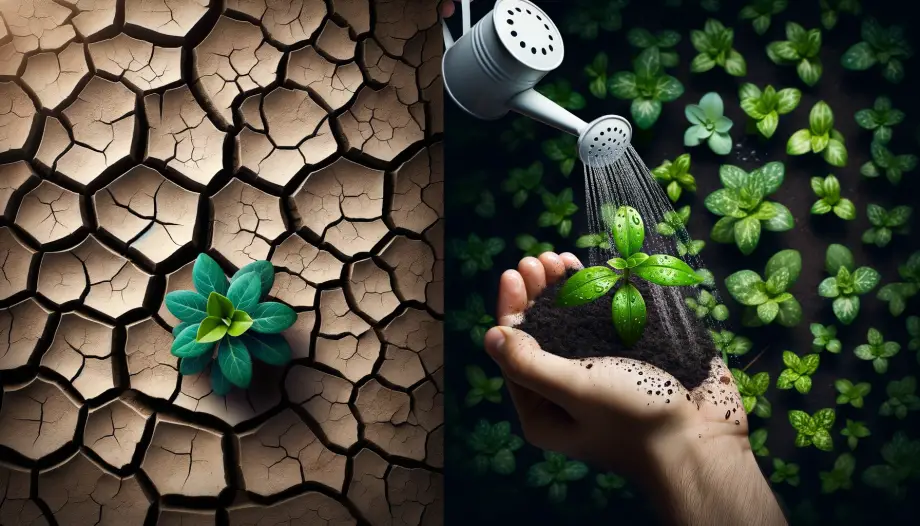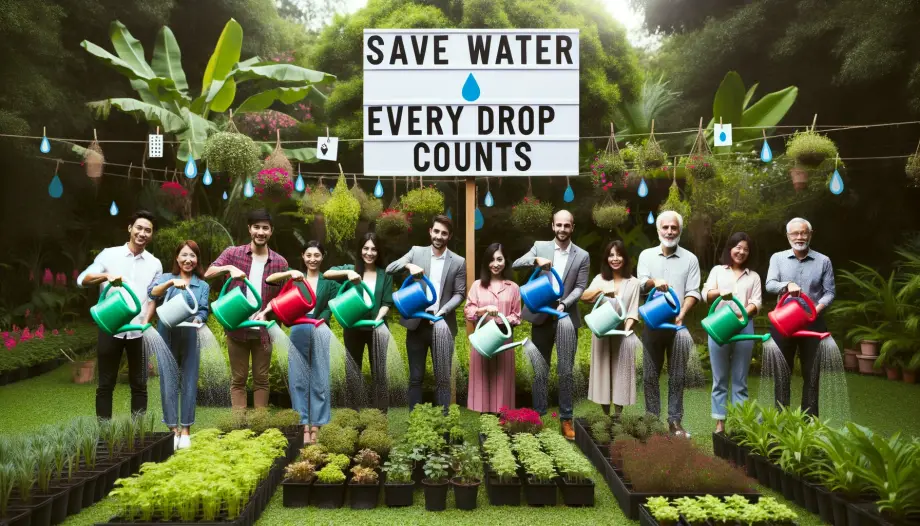
Explore water efficient landscaping ideas that save both water and your wallet, while keeping your garden lush and green.
Key Takeaways:
- Water efficient landscaping ideas focus on selecting plants that need less water like succulents and native plants.
- Setting up systems that water your plants more efficiently.
- Covering the soil with mulch to keep the water from evaporating quickly.
- These ideas help to cut down on water use and still have a lively, colorful garden.
Water Efficient Landscaping Ideas
Texas Sage Leucophyllum Frutescens – Low Maintenance Drought Tolerant Flowering Shrub
Welcome to the world of water efficient landscaping ideas where every drop counts!
Embarking on this journey will not only quench your garden’s thirst with less but will also unveil a beautiful symbiosis between nature and design.
It’s about crafting a green haven that’s kind to your pocket and the planet.
Water is life, but in many parts of the world, it’s a scarce commodity. The beauty of a lush, green lawn is undeniable, yet the water consumption can be concerning.
This is where water-efficient landscaping shines as a beacon of sustainability.
Through the integration of native plants and smart water conservation strategies, you can create an outdoor haven that’s both appealing and eco-friendly.
Planning and Preparation
A well-thought-out plan lays the foundation for a water-efficient landscape.
Understanding your garden’s current water usage and the local soil and climate conditions will guide your plant selection and design choices.
Assessing Current Irrigation System
Before diving into water-efficient landscaping, it’s crucial to understand your current water usage.
Assessing your existing irrigation system will shed light on the amount of water you use and where you might be wasting it.
Transitioning to a drip irrigation system can significantly reduce water wastage, ensuring that the precious liquid reaches the roots of your plants, not the sidewalk.
Identifying Climatic and Soil Conditions
Every drop of water counts, especially in arid climates. Understanding your local environmental conditions is pivotal.
Analyzing the soil type in your garden will provide insights into its water retention capabilities.
Soil improvement, through the addition of organic material like compost, can enhance its moisture-holding capacity, reducing the water needs of your plants.
Selecting Suitable Plants
Plant selection is a cornerstone of water-efficient landscaping.
Embrace native plants that are accustomed to the local climate and soil conditions.
They’ll not only require less water but also foster local biodiversity.
Drought-resistant plants and drought-tolerant groundcover are your allies in crafting a garden that quenches its thirst without draining your water bill.
Plant Selection
Creating a garden that’s both beautiful and water-wise starts with picking the right plants.
The aim is to cultivate a space that flourishes while sipping water, not gulping it.
Let’s unfold the leafy world of plant selection for water efficiency.
Drought-Tolerant Plants
Lavender Live Edible Aromatic Herb Plant
These are the warriors of a water-efficient garden, thriving with less water. Examples include succulents, lavender, and desert-adapted plants.
Native Plants
Native plants are a smart choice as they are already well-adapted to the local soil and climate conditions, requiring less water to thrive.
Using Ground Covers
Ground covers like clover or moss can provide a green carpet, needing less water and maintenance compared to traditional turf grasses.
Planting Perennials
Perennials are long-term residents of your garden, coming back year after year, often with lower water needs.
Selecting Plants with Similar Needs
Rudbeckia fulgida ‘Goldsturm’ (Black Eyed Susan) Perennial
Group plants with similar water and sunlight needs together to ensure efficient watering and less wastage.
Here’s a simple table showcasing some water-efficient plants:
| Plant Type | Examples |
|---|---|
| Drought-Tolerant | Succulents, Lavender |
| Native Plants | California Poppy, Black-Eyed Susan |
| Ground Covers | Clover, Moss |
| Perennials | Coneflowers, Sedum |
Each category of plants brings unique benefits to water conservation in your garden. Choose a mix to create a diverse, water-wise landscape.
Water Conservation Techniques
Saving water in the garden goes beyond just turning off the taps. It’s about implementing strategies that make every drop count.
Dive into these water conservation techniques that are both effective and easy to incorporate.
Efficient Irrigation Systems
Efficient irrigation systems, like drip irrigation or soaker hoses, minimize water waste by delivering water directly to plant roots.
They prevent over-watering, reduce evaporation, and can be timed to water during the cooler parts of the day, further saving water.
Drip Irrigation and Soaker Hoses
Greenhouse Micro Drip Irrigation Kit
Transitioning to drip irrigation or soaker hoses is like tuning your garden to a rhythm of water efficiency.
Drip irrigation delivers water drop by drop directly to the soil near the roots, minimizing evaporation and runoff.
Soaker hoses, on the other hand, allow water to seep slowly into the soil, ensuring deep watering that promotes root growth.
Both systems can be set up with timers for early morning or late afternoon watering, further reducing water loss and saving you time.
Your plants get the hydration they need, and you get to enjoy a lush garden with a lower water bill.
Soaker Hose 150 FT for Garden Beds
Mulching
Mulching is a gardener’s ally in retaining soil moisture. By covering the soil with a layer of organic material such as straw, leaves, or wood chips, you reduce water evaporation, suppress weed growth, and improve soil quality, making your garden more water-efficient.
Rainwater Harvesting

Harvesting rainwater through rain barrels or creating rain gardens allows you to collect water during rainy seasons and use it during drier times.
This practice lowers your water bill, reduces strain on water resources, and provides a natural, chlorine-free water source for your garden.
Landscape Design
Sedum Succulent Plants Ground Cover
Crafting a water-efficient landscape is an art that marries aesthetics with functionality.
The design phase is where your vision comes to life, with every plant and pathway placed with purpose.
Let’s explore how you can design your garden to be a haven of beauty without being a haven of high water usage.
Hydrozoning
Grouping plants with similar water needs together is known as hydrozoning.
This practice allows for more efficient irrigation, ensuring that each plant receives just the right amount of water it requires.
It’s like organizing your garden into different hydration zones, each with its own watering schedule.
Turf Management
Turf areas are often the thirstiest parts of a garden. By minimizing turf areas and opting for drought-tolerant landscape design, you can significantly reduce your garden’s water needs.
Alternatives like artificial turf or ornamental grasses and ground covers like Creeping Thyme can provide a green aesthetic without the green water bill.
Low-Impact Development Techniques
Creating depressions instead of raised areas in your garden can help capture and retain stormwater.
Implementing permeable hardscapes like gravel pathways allows rainwater to seep into the ground, reducing runoff and recharging the local water table.
It’s about designing with water conservation at the heart.
Maintenance and Retrofit Options
A well-maintained garden not only looks appealing but also operates on a lesser amount of water.
Likewise, retrofitting your landscape with water efficiency in mind can significantly trim down your water bill.
Let’s delve into how regular maintenance and smart retrofit options can keep your garden lush with less water.
Regular Maintenance
Regular check-ups of your irrigation system can unveil leaks that lead to water wastage.
Keeping the landscape weed-free ensures that the precious water isn’t being hogged by unwanted plants.
Moreover, mulching with organic material like grass clippings helps in retaining soil moisture, and minimizing water evaporation.
Retrofit and Replacement Options
Replacing thirsty plants with drought-resistant landscaping alternatives, and installing a smart sprinkler system can be game-changers.
Moreover, testing soil nutrients and pH levels before landscaping helps in understanding the soil’s water retention capacity, enabling you to make informed plant selection and irrigation choices.
Water-Wise FAQs
Embarking on a water-efficient landscaping journey can spark numerous questions.
This section aims to address some common queries to provide a clearer pathway towards achieving a water-wise garden.
Q: What are some drought-tolerant plants suitable for a low-water garden?
A: Cacti, lavender, and succulents are great choices as they require minimal watering. Their natural habitats are arid regions, making them perfect for a low-water garden.
Q: How can mulching help in water conservation?
A: Mulching acts like a shield, reducing water evaporation from the soil. It also suppresses weed growth, which competes with plants for water.
Q: What is hydrozoning and how can it be implemented?
A: Hydrozoning involves grouping plants with similar water needs together in the same area. This allows for more targeted watering, making irrigation more efficient and conserving water.
Q: Are there any online resources for selecting water-efficient plants?
A: The Water Use Classification of Landscape Species (WUCOLS) database is a great resource for finding plants suited to your region’s water availability.
Conclusion
Embracing water-efficient landscaping is more than just a nod to sustainability. It’s about crafting outdoor spaces that are resilient, beautiful, and harmonious with nature.
With the right mix of plant selection, design techniques, and maintenance practices, every droplet of water is honored and utilized efficiently.
Your garden can be a testament to the harmonious coexistence of beauty and sustainability.
















